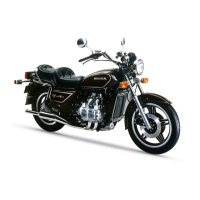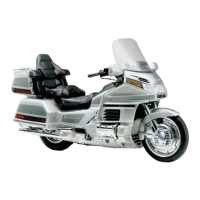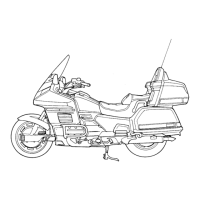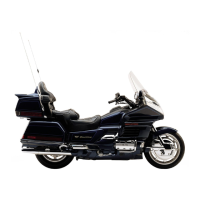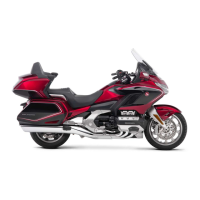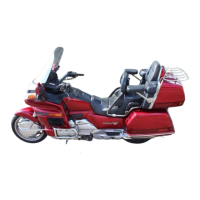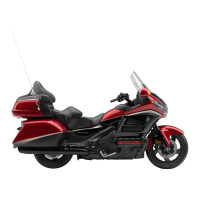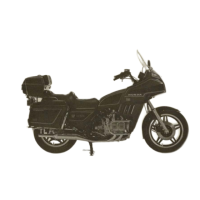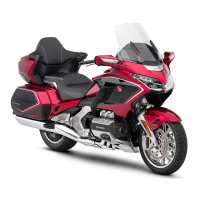
Do you have a question about the Honda Gold Wing 2018 and is the answer not in the manual?
| Engine Type | Horizontally opposed six-cylinder |
|---|---|
| Horsepower | 125 hp @ 5, 500 rpm |
| Torque | 125 lb-ft @ 4, 500 rpm |
| Seat Height | 29.3 inches |
| Fuel Capacity | 5.5 gallons |
| Compression Ratio | 10.5:1 |
| Induction | PGM-FI electronic fuel injection |
| Starter | Electric |
| Final Drive | Shaft |
| Wheelbase | 66.5 inches |
| Transmission | 6-speed |
| Front Tire | 130/70R-18 |
| Color Options | Candy Ardent Red |
| Ignition | Digital |
| Rear Suspension | Pro-Link |
| Front Brakes | Dual 320mm hydraulic discs |
| Rear Brake | Single 316mm disc |
| Rear Tire | 200/55R16 |
Maximum hazard warning indicating potential death or serious injury if instructions are not followed.
Hazard warning indicating potential death or serious injury if instructions are not followed.
Hazard warning indicating potential injury if instructions are not followed.
Information to help avoid damage to the motorcycle, other property, or the environment.
Guidelines to enhance rider safety, including routine inspections and wearing protective apparel.
Explains the purpose of safety and information labels on the motorcycle and warns of potential hazards.
Details essential safety precautions for riding, including protective apparel and system safety features.
Provides precautions for riding, covering break-in period, brakes, and bad weather conditions.
Advises against non-approved accessories and modifications that could compromise safety or warranty.
Guidelines for safe loading, including weight limits, securing luggage, and avoiding objects near hot parts.
Identifies various parts of the motorcycle and their corresponding page numbers for detailed information.
Details the motorcycle's instrument cluster, including speedometer, tachometer, and various displays like INFO 1, 2, and 3.
Details the various switches on the center panel, including interface dial, buttons, and their functions.
How to lock and unlock the steering to prevent theft, including the steering lock indicator.
Explains how the Honda SMART Key system works, its components, and how to activate/deactivate it.
Explains the function of the answer back system for locating the motorcycle and its operation.
How to apply and release the parking brake lever and check its function.
Explains the purpose of the Idling Stop system and how to switch it on/off.
Explains how the airbag system works, how rider injuries occur in frontal crashes, and the benefits of the airbag.
Overview of the audio system features, operation from handlebar and center panel switches, and safety precautions.
Access various setup options for the audio system, including sound, general, Bluetooth, and phone settings.
Explains how to connect iPhones, mobile phones, and Bluetooth headsets via Bluetooth, including supported profiles.
How to configure phone settings, including private mode, phonebook download, and microphone level.
How to select FM/AM radio and tune stations using various controls.
How to use Apple CarPlay with an iPhone via USB for calls, music, maps, and messages.
How to make and receive calls using the audio system without handling the phone, requiring a compatible phone and headset.
Step-by-step procedure for starting the engine, including SMART Key activation, steering lock, and gear selection.
Explains the 6-speed transmission, shift pattern, and what happens if the side stand is down while in gear.
How the Walking Speed mode assists in maneuvering at slow speeds, including operation, safety, and starting procedures.
How to use the reverse system to back out of parking spaces at slow speed, including safety precautions and operation.
How to change riding modes (TOUR, SPORT, ECON, RAIN) and the parameters they affect.
Explains how Torque Control limits rear wheel spin and how to turn it on/off via the multi-information display.
How the cruise control system maintains steady speed, its operating range, and intended use.
How the HSA system prevents rolling on inclines, its activation conditions, and releasing procedure.
How to open and close the fuel fill cap, fuel type, octane, and tank capacity.
Details on travel trunk, saddlebags, and fairing pocket, including opening, closing, and cargo limits.
Information on the shelter case for lightweight items, cargo limits, opening, closing, and safety.
Covers adjustments for handle grip heater and seat heaters for rider comfort.
How to adjust windscreen height, including automatic adjustment and keeping it raised after turning off the ignition.
How to operate and close the windscreen ventilation louver to direct airflow.
Stresses the importance of maintaining the motorcycle for safety, performance, and longevity.
Details the recommended maintenance requirements and intervals for ensuring safe, dependable performance and emission control.
Covers essential principles and procedures for performing maintenance tasks safely and effectively.
Advises using genuine Honda parts and specifying model name, color, and code when ordering.
Instructions on changing the spark plugs, including recommended types and heat range.
Information on checking and adding engine oil, including checking the level and procedures for adding oil.
Step-by-step guide for changing the engine oil and filter, including torque specifications and oil capacities.
Instructions for changing the clutch oil filter, including torque specifications and required oil.
Procedures for checking and adding coolant, and advice on changing coolant.
How to check and change the final drive oil, including recommended oil type and capacity.
Details on checking brake fluid, pads, and parking brake efficacy.
How to check the side stand operation and its safety function.
How to check clutch fluid level and system condition.
How to check the throttle operation for smoothness.
Instructions for cleaning the crankcase breather system.
Covers adjustments for headlight aim and clutch/brake levers.
How to adjust rear suspension preload using the multi-information display based on riding and load conditions.
How to adjust the spring preload of the rear suspension for load or road surface.
Instructions for replacing the Honda SMART Key battery.
Step-by-step guide to replace the Honda SMART Key battery, including battery type and precautions.
Troubleshooting steps for when the engine operates but does not start, or when the starter does not operate.
Procedures to follow when the engine overheats, including checking the radiator fan and coolant level.
Explains various warning indicators like low oil pressure, PGM-FI, ABS, torque control, and SMART Key indicators.
What to do when the low tire pressure indicator flashes or lights constantly, including checking air pressure.
Explains TPMS indicator function and reasons for its illumination, including interference and wheel replacement issues.
What to do if the AIRBAG indicator does not come on, stays on, or comes on while riding.
Explains when the HSA indicator comes on in amber and what it signifies.
Covers fuel gauge, handle grip heater, seat heaters, and coolant temperature gauge failure indications.
Troubleshooting for a blinking "-" in the gear position indicator, possibly indicating a DCT system problem.
Troubleshooting for issues with the Idling Stop system not operating correctly.
Steps to troubleshoot problems with the Honda SMART Key system, including activation and communication failures.
Procedure for activating the electrical system by inputting an ID number in emergency situations.
How to open saddlebags or travel trunk in an emergency using the built-in key.
Information on repairing punctures, using tire repair kits, and removing/installing wheels.
Troubleshooting common issues with the audio system, including pairing and connectivity problems.
Addresses issues like battery going dead, burned-out LEDs, and blown fuses.
Details about emergency key, built-in key, key tag, and Honda SMART Key operations and precautions.
Covers ignition switch, engine stop switch, odometer, tripmeters, owner's manual storage, and throttle system.
Legal disclaimers and terms of use regarding Apple CarPlay services.
Guidelines for washing the motorcycle, cleaning aluminum components, panels, and the windscreen.
Recommendations for storing the motorcycle outdoors or for extended periods, including battery care.
Guidelines for safely transporting the motorcycle on trailers or trucks, and warnings against towing.
Advice on using sensible cleaners and recycling wastes to protect the environment.
How to locate and record the VIN and engine serial number for registration and parts ordering.
Explains the TPMS function, low tire pressure indicator, and malfunctions.
Information on exhaust, crankcase, and evaporative emission control systems, and noise emission requirements.
Explains the function of catalytic converters and how to protect them.
Information on oxygenated fuels, their composition, and potential performance issues.
Information on ordering service manuals and other authorized publications.
Details on warranty coverage, maintenance recommendations, and how to obtain service.
Contact information for American Honda Motor Co., Inc., Honda Canada Inc., and dealer services.
Contact information for Honda Customer Service and updates on software.
How to report safety defects to NHTSA and obtain safety information.
Lists key specifications like overall length, width, height, wheelbase, and weight capacities for different models.
Provides critical service data including tire size, pressure, spark plug gap, engine oil, and torque specifications.
Lists the type of bulbs used for various lights on the motorcycle.
Lists the amperage ratings for various fuses used in the motorcycle's electrical system.
Lists torque specifications for various components like oil filter, drain bolts, axle bolts, and brake caliper mounting.
A section to record vehicle identification numbers, owner details, and dealer information.


